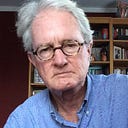
London Bridge is….
This is about London Bridge. And the traditional children’s nursery rhyme regarding that structure. And Lake Havasu City, Ariz.
It’s about a pair of landmarks I’ve been passing on my morning runs during visits to England since my daughter settled with her husband and young son in East London a couple of years ago.
I’ll start there.
Roughly a quarter mile from my daughter’s place, in expansive Victoria Park — with its crisscrossing paths peopled by runners, bicyclists, walkers, dogs and children — are two stone alcoves that stood on London Bridge from the 12th Century until 1831.
Then that London Bridge fell down. (You know the tune.)
An historic marker near those alcoves — there had been 14 on the bridge — cited their utility as a place for pedestrians to rest from dodging traffic, and that they also “might have served as places of ambush for robbers and cutthroats” until the establishment of night watchmen.
According to Peter Ackroyd’s exhaustive 2000 book, “London: The Biography,” that bridge was “the grandest work” in the city’s massive rebuilding surge during the 1100s; it “rose in stone and became the great highway of commerce and communication,” built on the same site where different iterations of London Bridge have existed for at least 1,500 years.
Isn’t history cool? After that grand stone London Bridge came down, its successor stood from 1831 to 1962, when it no longer could handle an increased load of traffic. At which point the city of London took it apart and sold massive fragments to an Arizona real estate developer who envisioned an odd way to attract tourists and retirement-home buyers.
Granite blocks from the famous span were transported to the Arizona outpost of Lake Havasu City and patched into a crossing over a channel canal that splits off from the Colorado River at the California border.
And in a 1973 country song, “London Homesick Blues,” Jerry Jeff Walker sang:
Well when you’re down on your luck and you ain’t got a buck In London you’re a goner. Even London Bridge has fallen down and moved to Arizona.
I’ve never been to Lake Havasu City, but they still call it London Bridge there, and you can take that reconstructed overpass to one side of the canal and be at Papa Leone’s Pizza; the other way, Barley Brothers Brewery. Not exactly like trekking across the River Thames from the vicinity of the 17th Century St. Paul’s Cathedral, designed by Christopher Wren, to within walking distance of the modern version of Shakespeare’s Globe theatre in the London borough of Southwark.
Ackroyd wrote that “the exact date cannot be known” when the original London Bridge was constructed of wood by the Romans, “but it would have seemed a majestic and even miraculous construction.
“Half the legends of London arose upon its foundations; miracles were performed and visions seen upon the wooden thoroughfare. Since its sole purpose was to tame the river, it may then have harnessed the power of a god. Yet the god may have been enraged at the stripping of its riverine authority; thus, all the intimations of vengeance and destruction invoked by the famous rhyme ‘London Bridge is broken down.’”
That enduring ditty may initially have referenced the 1014 Viking attack by Olaf of Norway, who “had his men maneuver their ships close to the bridge,” Ackroyd wrote, “tied them to its wooden piles with ropes and cables, then, assisted by the tide, strained at the wooden supports until they were dislodged and the bridge fell into the Thames.”
But a series of London Bridges, providing the only land transport across the river, endured. By the 14th Century London Bridge, long covered with houses and shops, lent a distinctive “sight of the city” described by Ackroyd: “Above the main gateway of the London Bridge rose iron spikes upon which the remnants of condemned men were fixed…the impaled heads of traitors.”
Not until the late 1890s did the more spectacular Tower Bridge appear (which modern visitors often confuse with the present London Bridge). Now of course there are a number of Thames crossings for cars and trains and, since 2000, the pedestrians-only Centennial Bridge.
And all the knaves and invaders and rascals and architectural geniuses and scallywags later, those alcoves sitting in Victoria Park can take a soul back to a childhood verse’s allusion to a world far away.
